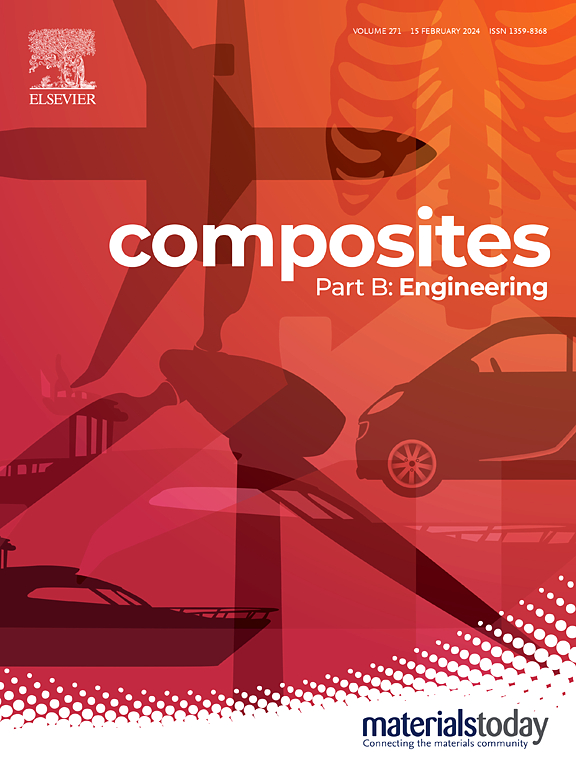Novel copper-based nanocomposite coatings achieving autonomous damage reporting and solar-triggered self-healing for marine corrosion protection
IF 14.2
1区 材料科学
Q1 ENGINEERING, MULTIDISCIPLINARY
引用次数: 0
Abstract
Developing efficient self-healing corrosion-resistant coatings remains a major challenge in metal protection. Herein, we propose a novel micron/nano-scale strategy to fabricate core-shell composite nanofibers (PVB-PVP-Cu2(OH)3NO3@Phen) via a one-step coaxial electrospinning process. The in-situ growth photothermal agent Cu2(OH)3NO3 (CON) and corrosion indicator phenanthroline (Phen) are simultaneously integrated, forming a multifunctional system. Remarkably, this work reports the first successful in situ synthesis of CON nanoparticles through one-step electrospinning, with the photothermal conversion mechanism corroborated through both experimental and simulation approaches. Integrated into a thermal-responsive epoxy resin, the composite nanofibers enable autonomous corrosion detection and photothermal-triggered self-healing, markedly enhancing both healing efficiency and corrosion protection. The BP-CON@Phen/EP coating rapidly heats to 61.0 °C under simulated sunlight within 200 s, promoting chain mobility and achieving a 95.04 % self-healing efficiency. After 140 days of immersion, the coating maintains strong protective properties with a stable impedance of 5.3 × 108 Ω cm2. Additionally, BP-CON@Phen enhances the resistance of the epoxy coating to temperature fluctuations and cathodic disbondment. Molecular dynamics simulations further indicate that BP-CON@Phen effectively obstructs corrosive media penetration, sustaining long-term corrosion resistance. This novel design strategy holds significant potential for advancing self-healing and corrosion-resistant coatings, offering high-performance solutions for diverse surface protection applications.

新型铜基纳米复合涂层实现自主损伤报告和太阳能触发自修复,用于海洋腐蚀防护
开发高效的自愈合耐腐蚀涂层仍然是金属保护领域的主要挑战。在此,我们提出了一种新的微米/纳米级策略,通过一步同轴静电纺丝工艺制备核-壳复合纳米纤维(PVB-PVP-Cu2(OH)3NO3@Phen)。原位生长光热剂Cu2(OH)3NO3 (CON)与腐蚀指示剂菲罗啉(Phen)同时集成,形成多功能体系。值得注意的是,这项工作首次成功地通过一步静电纺丝原位合成了CON纳米颗粒,并通过实验和模拟方法证实了光热转化机制。将复合纳米纤维集成到热响应环氧树脂中,可以实现自主腐蚀检测和光热触发的自修复,显著提高了修复效率和腐蚀防护能力。BP-CON@Phen/EP涂层在模拟阳光下200 s内迅速升温至61.0℃,提高了链迁移率,自愈率达到95.04%。经过140天的浸泡,涂层保持强大的保护性能,稳定的阻抗为5.3 × 108 Ω cm2。此外,BP-CON@Phen增强了环氧涂层对温度波动和阴极剥离的抵抗力。分子动力学模拟进一步表明BP-CON@Phen有效地阻挡了腐蚀介质的渗透,保持了长期的耐腐蚀性。这种新颖的设计策略在推进自修复和耐腐蚀涂层方面具有巨大的潜力,为各种表面保护应用提供高性能解决方案。
本文章由计算机程序翻译,如有差异,请以英文原文为准。
求助全文
约1分钟内获得全文
求助全文
来源期刊

Composites Part B: Engineering
工程技术-材料科学:复合
CiteScore
24.40
自引率
11.50%
发文量
784
审稿时长
21 days
期刊介绍:
Composites Part B: Engineering is a journal that publishes impactful research of high quality on composite materials. This research is supported by fundamental mechanics and materials science and engineering approaches. The targeted research can cover a wide range of length scales, ranging from nano to micro and meso, and even to the full product and structure level. The journal specifically focuses on engineering applications that involve high performance composites. These applications can range from low volume and high cost to high volume and low cost composite development.
The main goal of the journal is to provide a platform for the prompt publication of original and high quality research. The emphasis is on design, development, modeling, validation, and manufacturing of engineering details and concepts. The journal welcomes both basic research papers and proposals for review articles. Authors are encouraged to address challenges across various application areas. These areas include, but are not limited to, aerospace, automotive, and other surface transportation. The journal also covers energy-related applications, with a focus on renewable energy. Other application areas include infrastructure, off-shore and maritime projects, health care technology, and recreational products.
 求助内容:
求助内容: 应助结果提醒方式:
应助结果提醒方式:


